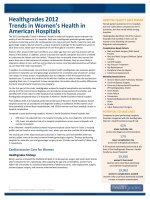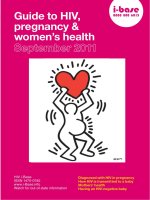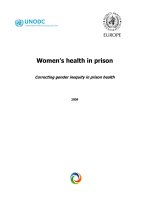Tài liệu Data and Information on Women’s Health in the European Union docx
Bạn đang xem bản rút gọn của tài liệu. Xem và tải ngay bản đầy đủ của tài liệu tại đây (5.22 MB, 92 trang )
Data and Information on Women’s Health
in the European Union
Faculty of Medicine Carl Gustav Carus
Research Association Public Health Saxony and Saxony-Anhalt
Technische Universität Dresden,
Dresden, Germany
2
3
The information contained in this publication does not necessarily reect the opinion or the
position of the European Commission.
Neither the European Commission nor any person acting on its behalf is responsible for any use
that might be made of the following information.
Europe Direct is a service to help you nd answers
to your questions about the European Union
Freephone number (*):
00 800 6 7 8 9 10 11
(*) Certain mobile telephone operators do not allow access to 00 800
numbers or these calls may be billed.
Cataloguing data can be found at the end of this publication.
ISBN-978-92-79-13659-7
© European Communities, 2009
Reproduction is authorised provided the source is acknowledged.
2
3
Authors
Kerstin Thümmler
Faculty of Medicine Carl Gustav Carus
Research Association Public Health Saxony and Saxony-Anhalt
Technische Universität Dresden,
Dresden, Germany
Amadea Britton
Faculty of Medicine Carl Gustav Carus
Research Association Public Health Saxony and Saxony-Anhalt
Technische Universität Dresden,
Dresden, Germany
Wilhelm Kirch
Faculty of Medicine Carl Gustav Carus
Research Association Public Health Saxony and Saxony-Anhalt
Technische Universität Dresden,
Dresden, Germany
List of Contributors
Wilhelm Kirch
Faculty of Medicine Carl Gustav Carus
Research Association Public Health Saxony and Saxony-Anhalt
Technische Universität Dresden,
Dresden, Germany
Robert Bauer
Austrian Road Safety Board (kfV)
A-1100 Vienna
Austria
Kerstin Thümmler
Faculty of Medicine Carl Gustav Carus
Research Association Public Health Saxony and Saxony-Anhalt
Technische Universität Dresden,
Dresden, Germany
Claudia Schindler
Faculty of Medicine Carl Gustav Carus
Research Association Public Health Saxony and Saxony-Anhalt
Technische Universität Dresden,
Dresden, Germany
Amadea Britton
Faculty of Medicine Carl Gustav Carus
Research Association Public Health Saxony and Saxony-Anhalt
Technische Universität Dresden,
Dresden, Germany
4
5
Ines Kube
Faculty of Medicine Carl Gustav Carus
Research Association Public Health Saxony and Saxony-Anhalt
Technische Universität Dresden,
Dresden, Germany
Grit Neumann
Faculty of Medicine Carl Gustav Carus
Research Association Public Health Saxony and Saxony-Anhalt
Technische Universität Dresden,
Dresden, Germany
Acknowledgements:
The following literature update on women’s health in the European Union was reviewed for DG SANCO
and the European Commission by Dr. med. Natalie M. Schmitt, a Johns Hopkins Bloomberg School
of Public Health MPH graduate and expert in the eld of Women’s and Reproductive Health. The
authors would also like to thank Anna Klamar and Sabrina Gaitzsch for their invaluable assistance
in the preparation of this report.
4
5
Data and Information on Women’s
Health in the European Union
European Commission
6
7
Foreword
Dear Reader,
This report “Data and Information on Women’s Health in the European Union” provides a
short overview concerning women’s health.
This report provides an overview of the main topics, as a necessary rst step for further
work. Of course, much more could be done in all the areas covered for example in the mental
health area on “violence against women”, or in the lifestyle areas on smoking and alcohol.
Nevertheless, this report provides an overview of issues related to women’s health across
the EU Member States also including EEA countries. It highlights gaps and special topics
where research and more information are needed.
Some of the principal ndings of this report are the following:
-the main causes of death in women in the EU and EEA are cardiovascular disease (CVD) and
cancer,
- Women are particularly affected by mental health problems such as depression, dementia
and Alzheimer’s
-there is a great need for further research into how certain diseases affect women in particu-
lar.
The women’s health report is the rst step to look into gender health aspects under differ-
ent angles. The next gender report will be the “First European Men’s health report” which is
currently being prepared.
Let me express my hopes that this report will already provide a useful overview and help to
identify areas where more action is need.
Andrzej Ryś
Director - Public Health and Risk Assessment
6
7
Contents
Summary 11
Introduction 17
Demographic and socio-economic Trends 21
Population Structure 22
Social Trends – Marital status of women across the lifespan 24
Life Expectancy 24
Healthy Life Years 25
Population Change 26
Education and Employment 29
Health Issues 33
Cardiovascular Diseases 34
Coronary heart disease (CHD) 34
Cerebrovascular disease (stroke) 34
Cancer 35
Breast Cancer 35
Cervical Cancer 36
Lung cancer 37
Colorectal Cancer (Colon and rectal cancer) 38
Infectious diseases 38
HIV/AIDS 38
Inuenza 39
Syphilis (Treponema pallidum) 40
Chlamydia 40
Gonorrhoea 40
8
9
Vaccination coverage 41
Sexual and Reproductive health 42
Fertility 42
Pregnancy outcome 42
Maternal mortality 43
Abortion 43
Sexual and intimate partner violence 44
Endometriosis 45
Diabetes mellitus 46
Mental health 47
Dementia and Alzheimer’s disease 47
Depression 48
Musculoskeletal Disorders 49
Rheumatoid arthritis 49
Osteoporosis and osteoporotic fracture 50
Lifestyle 53
Smoking 54
Alcohol consumption 55
Overweight, Obesity and Eating Disorders 57
Physical Activity (PA) 58
Drug and substance abuse 59
Accidents and Injuries of Women in the EU 60
Health care 65
Access to health care 66
Quality of Health care 69
Responsiveness of healthcare to specic needs of women 70
8
9
HPV vaccination 70
Health promotion of physical activity (PA) among working women 71
Conclusion 74
Recommendations 76
Glossary 80
References 81
List of abbreviations 87
10
11
10
11
Summary
12
13
This report presents an overview of the state of women’s health in the European Union. The report
focuses on women aged 15 years and older in the 27 EU-Member States, as well as the EEA
countries Norway, Iceland, and Liechtenstein, and occasionally Switzerland.
The report is divided into six chapters. The rst chapter introduces the report and its goals and
methodologies. Chapter 2 deals with changing demographic and socio-economic trends that are
pertinent to women’s health. Chapter 3 provides an overview of the main issues in women’s health
and describes different trends, risk factors, and health determinants. Supplementing this information,
Chapter 4 concentrates on the main lifestyle-related determinants of diseases that affect women,
such as tobacco and alcohol use. Chapter 5 provides an overview of women’s access to health
care, the quality of health care provided for women, and the responsiveness of different health
care systems to women’s needs. Finally, Chapter 6 concludes the report with a summary of key
information presented in the report and recommendations for policy makers and stakeholders for the
promotion of women’s health across the European Community.
Demographic and socio-economic trends
Overall, there are marginally more men than women in Europe, with the proportion of women
increasing in older age categories. In 2005, there were approximately 15% more women than men
among those aged 65-69 and almost two times more women than men aged over 80, leading to a
total of 43% more women than men aged 65 and over (EUROSTAT 2008a, 2008b).
In all European countries, life expectancy is greater for women than for men, with the largest gap
between the sexes in Lithuania (11.7 years) and the smallest in Iceland (3.4) (based on 2006 data).
Eurostat predictions indicate that in 2010 average life expectancy for women will range from 76.5 to
84.5 years and in 2050 it will have increased to 82 to 89.1 years (EUROSTAT 2008a).
On average European women reach higher levels of education than men. However, women are
also more likely to receive lower wages: in 2006 women in the EU-27 earned on average 15% less
per hour than men. Women also spend more of their time doing unpaid work than men (women
average 278 minutes a day of unpaid domestic work, while men spend less than half of that time
(EUROSTAT 2008b).
Health issues
Breast cancer is the most common form of incident cancer and the dominant cause of cancer-related
death among women aged 0-74 across the European Union. Female mortality due to lung cancer
is signicantly lower than that of breast cancer, and is also lower in women than men, but has been
steadily rising (Bosetti et al 2008, Boyle Lewin 2008).
Across the EU/EEA countries, men are more affected by HIV than women, with an infection ratio of
2:1. In women the predominant routes of transmission are heterosexual contact and injection drug
use (ECDC 2008a).
In terms of other sexually transmitted infectious diseases, a number of European countries showed
a recent increase in new chlamydia infections. This is particularly relevant to women as chlamydia
is more often diagnosed in women than in men (ESSTI 2008).
The total fertility rate among the countries of the EU is very low, having declined from 2.6 in early
1960 to 1.4 in 1995-2005. Meanwhile, the mean age of women bearing children increased at
12
13
least two years in the period 1995-2006, meaning women are giving birth later and having fewer
children. Southern European countries have the highest percentages of low birth weight babies
(Spain, Portugal, Greece), whereas Northern countries have the lowest percentages. Abortions in
adolescents and young women less than 20 years of age remain high, having increased during the
period 1995-2005 (EUROSTAT 2008a).
Diabetes is a growing problem and it is estimated that between 2007 and 2025 Germany, Italy, and
France will have the greatest increases in women aged 20-79 years with diabetes mellitus (DM)
(IDF 2006). For women the average death rate due to DM was 12.8 and among individual countries
the highest rates were observed in Cyprus (35.5), Portugal (25.3), Austria (23.4), and Malta (19.2)
(EUROSTAT 2009).
The prevalence of dementia and Alzheimer’s disease (AD) is higher among elderly women than
among elderly men. Signicant gender differences are found in the incidences of AD after the age
of 85 years.
Depression is more common in women than in men (lifetime prevalence: 9.4%; 12-month prevalence:
2.8%) (European Commission 2008b). Studies reveal prevalence of suicide attempts is two times
higher in women than in men (DG for Health and Consumers 2008).
Lifestyle
Smoking prevalence is lower in women than in men, however, this gap has been closing in recent
years due to decreasing numbers of men smoking and increasing numbers of women smoking in
certain countries. In addition, smoking-associated deaths among women are still on the rise in some
Eastern European countries. Young girls are more likely to smoke than boys, particularly in Northern
and Western European countries. (WHO 2009b)
Across the EU overall drug use is more common in men than in women, but the use of tranquilisers
and sedative substances is more common in school-aged girls than boys in most EU-Member States
(EMCDDA 2006).
The prevalence of overweight and obesity is rapidly increasing in many European countries for both
sexes. The highest percentages of women with obesity were found in Austria, the UK, and Germany
(IOTF 2009).
Data on specic eating disorders, such as bulimia nervosa, are rare. However, the generally accepted
prevalence rate of bulimia nervosa is about 1% among young women (Hoek 2006).
14
15
Health care
Reliable and comparable data on access to health care across the EU-27 Member States is limited.
The most comprehensive available data comes from the 2007 Eurobarometer Survey Health and
Long-Term Care in the European Union, which is a public opinion survey and sufcient only to
suggest potential trends. Based on those women interviewed for the survey, the majority of European
women report having easy access to health care. Approximately 88% of women felt that it was easy
to access a family doctor or general practitioner. However, the survey suggests that access to
health services varies widely within and across Europe (DG Employment, Social Affairs and Equal
Opportunities 2007).
Current data on health care utilization in Europe tends to make no distinction between sexes.
Gendered data on healthcare expenditures is lacking and data on health care costs and health
insurance coverage for women is weak.
Comparable data on screening volume and health promotion programme participation is limited. As
of 2007, in a review of the EU-27, breast cancer screening was available at the population level in
eleven countries (IARC 2008a).
Conclusions and Recommendations
There is persistent evidence that sex and gender differences are not only relevant for reproductive
health issues, but also for the prevalence of diseases, risk factors, and health care among women. It is
essential to acknowledge that differences in health between women and men are due to interactions
between environmental, behavioural, and biological factors. It is important to keep in mind that this
report is not intended to cover all facets of the health status of women in the EU. The subject areas
addressed are limited by their relevance to women’s health, the availability of reliable and topical
data for all or most EU-27 Member States and the EEA, and the availability of data in a sex-specic
format, which is not the case for many elds. In light of this, the main recommendation of this report
is to implement standardised gendered data collection and to improve data quality in areas where
current data is either non-existent or non-sex-specic, including access to health care, health care
expenditures and costs, specic eating disorders, pain and migraine, alcohol use, smoking habits,
and abuse and misuse of legal medications.
14
15
“Life on the planet is born of woman”
Adrienne Rich
16
17
16
17
Introduction
18
19
Women’s health’ encompasses more than pregnancy and reproductive health. In many parts of the
world a woman’s reproductive years comprise less than half of her life. Weisman’s denition (1998)
of ‘women’s health’ addresses the complexity of the eld, highlighting that
- health is a product of cultural, social, and psychological factors, as well as biology;
- it is important to consider and emphasize a lifespan and multiple role perspective;
- the individual and society have to promote health and prevent disease in order to full the concept
of health beyond the absence of disease.
Based on this understanding of women’s health, the exclusive focus adopted by this report on
women and their corresponding health issues and needs is necessary to adequately address the
topic. There are diseases which are unique, more prevalent, or more serious in women and for some
diseases risk factors and interventions are different for women and men. Changes in diseases over
time and across the lifespan also differ between women and men. Furthermore, women’s health
is signicantly associated with differences in gender equality in social, educational, cultural, and
economic status (Schmitt 2008). In light of these sex-dependent factors, there is much to be gained
by approaching women’s health as its own important eld.
This report presents an overview of the state of women’s health in the European Union and addresses
both the differences between men and women and the differences among women living in different
Member States. It examines the main patterns of mortality and morbidity and the health risk factors at
different stages of women’s lives and reports on the current situation and recent trends in European
women’s health. It also provides information about the inuence of demographic trends and socio-
economic factors on women’s health.
The report is divided into ve chapters: demographic and socio-economic trends; women’s health
issues; lifestyle; health care; and conclusion and recommendations for future research in the eld
of EU women’s health.
Each chapter is subdivided into separate sections addressing specic issues in women’s health
which are oriented around the health indicators developed by the European Community Health
Indicators project (ECHI) (Kilpeläinen et al. 2008).
18
19
The focus is on women aged 15 years and older in the 27 EU-Member States, as well as Norway,
Iceland, and Liechtenstein, as shown in Table 1.
The main sources used in the preparation of the report include:
- the Statistical Ofce of the European Communities (EUROSTAT 2009),
- the Organisation for Economic Co-Operation and Development (OECD),
- the World Health Organization (WHO) databases: European Health For All Database (HFA),
European mortality database (MDB), Alcohol control database, Tobacco control database,
- various reports and publications from organisations working on specic women’s health
issues,
- literature searches in academic publications available through the PubMed database.
Table 1: Member States of the EU
Member States of the EU (EU-
27)
Austria Luxembourg
Belgium Malta
Bulgaria Netherlands
Cyprus Poland
Czech Republic Portugal
Denmark Romania
Estonia Slovakia
Finland Slovenia
France Spain
Germany Sweden
Greece United Kingdom
Hungary
Ireland Additional Countries
Italy Norway
Latvia Iceland
Lithuania Liechtenstein
20
21
20
21
Demographic and
Socio-economic
Trends
22
23
Between 1960 and 2007 the population in the current EU-27 countries expanded from 403 million
people to around 495 million people (EUROSTAT 2008a). Factors that inuence population change,
such as life expectancy, fertility and mortality rates, and net migration are currently undergoing
signicant change, as are other socio-demographic behaviours such as marriage rates. In addition,
the socio-economic status of women is changing. More women are employed and reaching higher
levels of educational attainment, which has resulted in greater female autonomy. There are still
signicant gender gaps in elds of employment and education and in time spent doing unpaid work
(such as household chores, childcare, and care of elderly and sick family members). These trends
are signicant for women’s health.
Population Structure
Size
In 2006 the population of the combined EU-27 Member States was 494,049,094 —including
252,956,162 women (EUROSTAT 2009). Germany had the largest absolute female population
(42,055,887), followed by France (32,489,038), the UK (30,914,956), and Italy (30,318,835)
(EUROSTAT 2009).
Sex Ratio
There are marginally more women than men in Europe (104.9 women for every 100 men in the EU-
27 in 2007), but the sex ratio varies by age group, as shown in gure 1. Among live births in 2005
in EU-25 countries, 51.3% were boys, while 48.7% were girls (EUROSTAT 2008b). Men outnumber
women until the age of 45, after which the proportion of women relative to men increases in each
successive age category. In 2005, there were approximately 15% more women than men among
those aged 65-69 and almost two times more women than men aged over 80, leading to a total of
43% more women than men aged 65 and over (EUROSTAT 2008a; EUROSTAT 2008b).
Fig. 1: Women per 100 men in the combined EU-27 population in 2007. (EUROSTAT 2009)
Age Categories
Decreasing fertility and increasing life expectancy have led to overall population ageing. In 1990,
19% of the EU-25 population was under 15 and 14% was 65 or over—by 2005 those numbers had
22
23
changed to 16% and 17% respectively (EUROSTAT 2008b). By 2007, 16.9% of the total population
in the combined EU-27 Member States was over 65 years old — ranging from 10.9% in Ireland to
19.9% in Italy (EUROSTAT 2009).
Eurostat predicts a continued demographic shift towards greater percentages of the European
population in older age categories. This shift is expected to have signicant consequences, including
impacting the school-age population, family structures, labour force participation, health care, social
protection and social security issues, government nances, and economic competitiveness. As
women already comprise larger percentages of the age categories expected to increase in size,
elderly women are an increasingly important demographic group (EUROSTAT 2008a).
Fig. 2: Percentages of EU-27 women and men in different age categories in 2006. (EUROSTAT 2009)
24
25
Social Trends – Marital status of women across the lifespan
The age at which women rst marry has increased in the EU in recent years, a result of more time
spent in education and increased priority being placed on the establishment of a professional career
before marriage. Average age at rst marriage is similar across Europe and overall, women still
marry slightly younger than men (EU average in 2003 was 29.8 for men, 27.4 for women). However,
the age difference is small across most of the EU. The largest gap in age at rst marriage, based
on data from 2003, occurs in Greece (3.8 years) (EUROSTAT 2008b). There has also been a trend
toward an overall reduction in the number of marriages and an increase in the number of divorces
in Europe (EUROSTAT 2008a).
Life Expectancy
Life expectancy is the average number of years that an individual is expected to live if mortality
patterns remain unchanged for the duration of his or her lifespan (WHO 2008). Life expectancy
at birth is greater today than it was in 1995 for women from all parts of Europe, a result of better
living conditions and health care and greater awareness of health issues (EUROSTAT 2008a).
The greatest increases since 1995 have been observed in Estonia (4.3 years) and other Eastern
European countries, as well as in Ireland (3.8 years) (EUROSTAT 2009).
For female children born in 2006, life expectancy ranges from 76.2 years in Romania to 84.4 years
in France and Spain. Life expectancy at birth is relatively low for Bulgarian women and high for
women from Sweden, Liechtenstein, and Finland.
For women aged 65 in 2005, life expectancy was highest in France (22.6 additional years of life) and
lowest in Bulgaria (16.3 additional years) (EUROSTAT 2009).
In all European countries, life expectancy for women is greater than that for men. The greatest gap
between the sexes, based on 2006 data, occurs in Lithuania (11.7 years) and the smallest gap is in
Iceland (3.4), as shown in gure 3. However, the gap between life expectancies has been closing
in recent decades, potentially due to increased similarities in lifestyles between the sexes (e.g.
increased smoking among women), and this trend is likely to continue, with the greatest gains for
males in the newest EU-Member States (EUROSTAT 2008a). Eurostat predictions indicate that in
2010 life expectancy will range from 65.8 years (in Latvia) to 79.1 years (in Sweden) for men and
from 76.5 years (in Romania) to 84.5 years (in Spain) for women; in 2050 it is projected to range
from 74.3 years (in Latvia) to 83.6 years (in Italy) for men and 82 years (in Romania) to 89.1 years
(in Spain) for women (EUROSTAT 2008a).
24
25
Fig. 3: Average life expectancy in years of women and men in the EU-27 in 2006. (EUROSTAT 2009)
Healthy Life Years
With more women living longer lives the quality of the additional years becomes a central question.
Healthy life years (HLYs), also referred to as disability-free life expectancy, is the number of remaining
years of life that a person of a specic age is expected to live without any moderate or severe health
problems or acquired disabilities (EUROSTAT 2008a). The indicator is meant to complement life
expectancy data and provides information on the quality of years lived rather than the quantity.
HLYs also provide information on the structural and nancial burdens the health care system faces
as women age.
Overall, across Europe, women are expected to live a slightly smaller proportion of their years in
good health than men (75.4% versus 80.7%) (EUROSTAT 2009). In the EU-25 in 2006, men were
on average expected to have 61.6 HLYs, while women were expected to have 62.1 HLYs, as shown
in gure 4 (EUROSTAT 2009). Combined with their longer average life expectancy, this means
women experience more years of disability than men.
For women in the EU in 2006, HLYs expected at birth ranged from 52.1 in Latvia to 69.2 in Malta,
with women in Slovakia, Finland, and Estonia expected to have fewer than 55 HLYs and women in
Denmark, Greece, Ireland, Iceland, Italy, Sweden, and the UK expected to have more than 65 HLYs
(EUROSTAT 2009).
Among women 65 and over in 2006, women from Denmark had the largest number of expected
HLYs remaining (14.1) while Slovakian women had the smallest (3.8) (EUROSTAT 2009).









